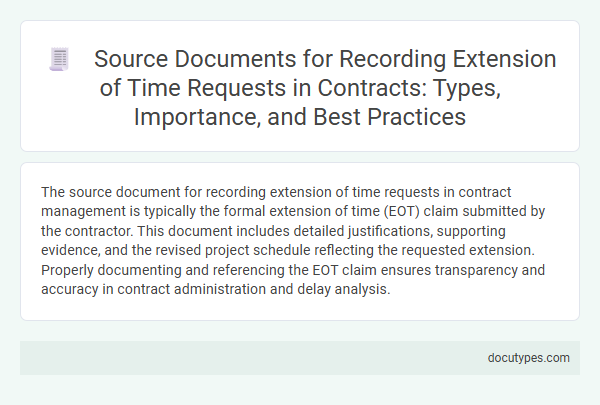The source document for recording extension of time requests in contract management is typically the formal extension of time (EOT) claim submitted by the contractor. This document includes detailed justifications, supporting evidence, and the revised project schedule reflecting the requested extension. Properly documenting and referencing the EOT claim ensures transparency and accuracy in contract administration and delay analysis.
Introduction to Extension of Time Requests in Contracts
Extension of Time (EOT) requests are formal notices submitted by a contractor to amend the originally agreed project timeline. These requests address delays caused by unforeseen events impacting the construction schedule.
The source document for recording Extension of Time requests is typically the contract's EOT claim form or a dedicated delay notice template. Accurate documentation within this source ensures transparency and supports dispute resolution between contracting parties.
Defining Source Documents for Extension of Time
Source documents for recording extension of time requests typically include the original contract, written extension requests, and supporting evidence such as correspondence or site reports. These documents establish the legitimacy and details of the time extension claim, ensuring accurate and transparent record-keeping. Proper identification of source documents is essential for resolving disputes and maintaining contractual compliance.
Common Types of Source Documents Used
The source document for recording extension of time requests in contract management typically includes formal communications and official records that justify the need for additional time. These documents serve as the primary evidence supporting the claim for an extension.
Common types of source documents used include delay notices, change orders, and claim submissions. Delay notices are sent by contractors to inform the client about events causing project delays. Change orders reflect agreed modifications in the contract scope that impact the project timeline, while claim submissions provide detailed explanations and proofs backing the extension request.
Importance of Accurate Source Documentation
The source document for recording extension of time requests is typically the original contract and any relevant change orders or formal correspondence. Accurate source documentation ensures proper validation and approval of time extensions, safeguarding your project timeline and legal standing.
- Original Contract - Defines the baseline schedule and terms for any extension requests.
- Change Orders - Official documents that authorize modifications to the contract scope or duration.
- Formal Correspondence - Written communications that support and clarify extension requests.
Legal and Contractual Requirements for Documentation
| Aspect | Details |
|---|---|
| Source Document | Extension of Time (EOT) Request Form or Notice |
| Legal Basis | Contractual clauses outlining procedures for submission and approval of time extensions |
| Contractual Requirements | Formal written notification specifying reasons, supporting evidence, and impact on project timeline |
| Documentation Standards | Compliance with contract terms, regulatory guidelines, and industry best practices for record-keeping |
| Required Supporting Documents | Delay analysis reports, correspondence records, project schedules, and proof of cause events |
| Submission Timeline | Strict adherence to deadlines stipulated in contract for timely processing and approval |
| Approval Authority | Project manager, contract administrator, or designated authority as per contractual agreement |
| Record Retention | Secure storage of approved EOT documentation for audit, dispute resolution, and legal compliance |
Best Practices for Collecting Source Documents
The source document for recording extension of time requests typically includes formal change order requests or written correspondence detailing the reasons and duration for the extension. Collecting accurate source documents ensures clear communication and proper contract management.
- Request Documentation - Gather signed change order requests or formal letters submitted by the contractor outlining the extension reasons.
- Supporting Evidence - Collect relevant daily logs, site reports, or delay analysis supporting the validity of the extension request.
- Timely Submission - Ensure your source documents are submitted promptly and comply with contract requirements to avoid disputes.
Electronic vs. Paper Source Documents: Pros and Cons
The source document for recording extension of time requests serves as the official record that justifies and authorizes the adjustment of contract deadlines. It can exist in electronic or paper format, each with distinct advantages and challenges.
Electronic source documents enable faster processing, easy access, and improved tracking of extension requests through digital systems. They reduce the risk of physical loss and support seamless integration with project management software.
Paper source documents provide a tangible, signed record that some stakeholders may prefer for legal and archival purposes. However, they are prone to misplacement, slower handling, and increased storage requirements.
Choosing between electronic and paper source documents depends on the project's scale, regulatory environment, and stakeholder preferences. Effective contract management often involves balancing digital efficiency with the reliability of physical records.
Ensuring Authenticity and Reliability of Documents
What is the source document for recording extension of time requests in a contract? The source document is typically the Extension of Time (EOT) request submitted by the contractor, which outlines the reasons and justifications for the delay. Ensuring the authenticity and reliability of this document involves verifying signatures, timestamps, and supporting evidence such as site logs or correspondence records.
Common Mistakes in Documenting Extension of Time Requests
The source document for recording extension of time requests is typically the official contract amendment or change order that formally acknowledges the time extension. Accurate documentation is crucial to avoid disputes and ensure clear communication between all parties involved.
- Failure to Reference the Original Contract - Omitting specific references to the original contract clauses can lead to ambiguous claims and misunderstandings.
- Incomplete Justification - Not providing detailed reasons and supporting evidence for the extension weakens the validity of the request.
- Late Submission - Submitting extension requests after the deadline specified in the contract often results in denial or disputes.
Your careful attention to these details strengthens the reliability of extension time records and contract compliance.
What Is the Source Document for Recording Extension of Time Requests? Infographic

